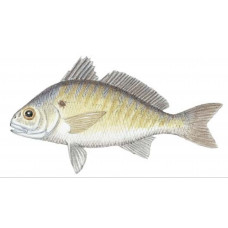Latin name
Leiostomus xanthurus
Other names
Norfolk spot, spot croaker; French: tambour croca; Spanish: verrugato croca.
Identification
The spot body is short, tall, and compressed, and the tail is slightly forked. The dorsum in front of the fin is pointed. The mouth is small, horizontal. Upper jaw with a band of weak teeth, lower jaw with few or no teeth. The soft dorsal fin has more than 30 rays, and the anal fin has more than 12 rays. The coloration is gray to silvery, with a golden hue on the sides and 12-15 dark lines extending from the dorsal fins to the lateral line. Above each pectoral fin is a round black spot about the size of an eye. The fins are pale yellow, except for the dorsal and caudal fins, which are milky. The coloration of the spot and the absence of chin spines distinguish it from other sciaenids.
Distribution
Spot occurs from Massachusetts to Mexico, inhabiting approximately the same range as the Atlantic croaker. It lives off the Atlantic coast of North America and in the Gulf of Mexico, from Cape Cod to the coast of Texas.
Habitat
Sea-bottom shelf fish entering brackish and fresh waters. Spot lives in estuaries and coastal saltwater, usually wading on sandy and muddy bottoms. They can live in depths of up to 197 feet, but usually stay much shallower.
Size
The average individual weighs 1⁄2 pound, these fish rarely reach 2 pounds. They can live up to 5 years.
Life history and Behavior
Spawning occurs in the sea in the fall and winter, with water temperatures ranging from 59° to 79 °F. The female is capable of producing almost 1 million eggs. The eggs are in the pelagic zone and are carried by wind and currents to shore. The young move to less salty areas of the estuary, sometimes even to fresh water, until they are old enough to return to salt water. During the first few years, they grow rapidly due to the abundance of food in the estuaries. They reach maturity at age 3. It is a schooling fish and travels in groups of 100 or more. It migrates from the coast to the open sea in the fall and comes back to shore in the spring.
Food and feeding habits
Spot consumes small crustaceans, detritus, worms, and small fish. In Texas lagoons, they eat small invertebrates and detritus; in North Carolina estuaries, they eat phytoplankton, algae, sea grasses, worms, clams, copepods, mysids, and small shrimp.
Reproduction
On the U.S. Atlantic coast, spawning occurs during the fall-winter period (November-March) in marine bays and small bays. In the Gulf of Mexico, it spawns in December-March, for which it leaves lagoons, bays and coastal gulfs; spawning takes place near the entrances to these bodies of water. Fertilized eggs are 0.65-0.80 mm in diameter and just hatched prelarvae are 1.5 mm long.
| Classification | |
| Phylum | Chordata |
| Class | Actinopterygii |
| Squad | Acanthuriformes |
| Family | Sciaenidae |
| Genus | Leiostomus |
| Species | L. xanthurus |
| Features | |
| Conservation status | Least Concern |
| Habitat | Littoral |
| Life span, years | No information |
| Maximum body weight, kg | 1.13 |
| Maximum length, cm | 30.48 |
| Sailing speed, m/s | No information |
| Threat to people | Edible |
| Way of eating | Predator |
Spot
Tags: Spot



